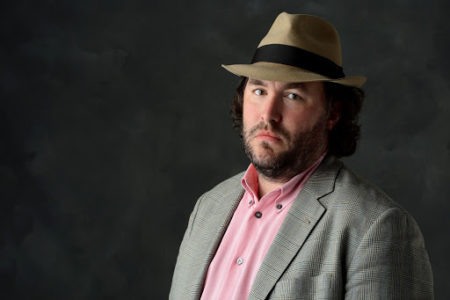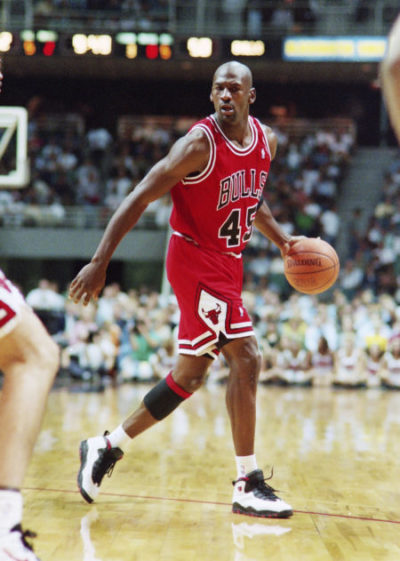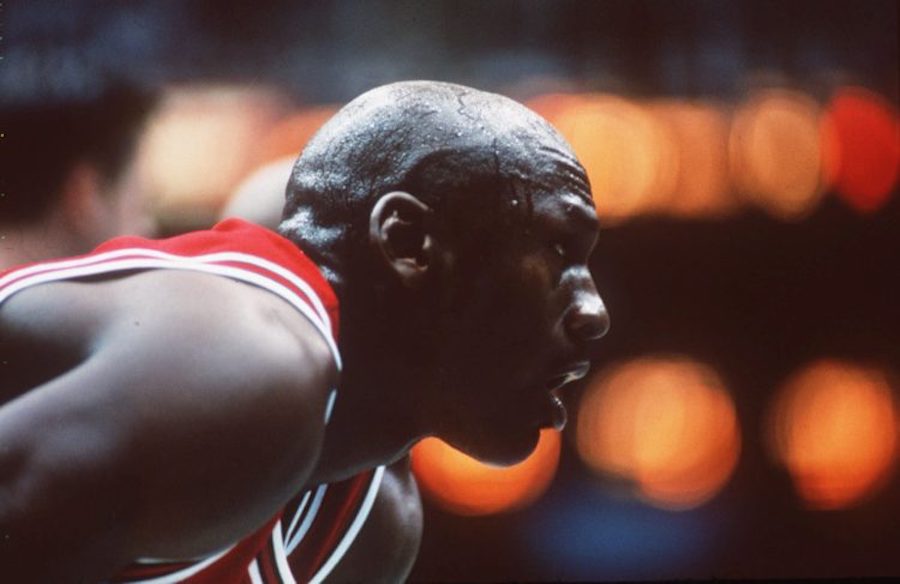With transportation stymied by a pandemic, Wright Thompson couldn’t exactly hop on a plane to research a story on Michael Jordan. Instead, the ESPN senior reporter built a time machine, one interview at a time.
The resulting story is “Michael Jordan: A History of Flight,” written to coincide with ESPN's high-profile documentary “The Last Dance,” a 10-episode series that first broadcast this past spring. But Thompson’s accompanying profile isn’t just another ode about one of the most covered athletes of the last quarter-century; it’s a revealing portrait of the beautiful — and often bloody — land that shaped the basketball superstar, from his burning drive to his barbed-wire glare.
The story is dotted with familiar signposts for sports fans, such as Jordan’s signature shoes and the instantly recognizable intro music for the Chicago Bulls, the NBA team Jordan played with for 14 years, leading them to six championships. But Thompson is uninterested in hagiography. Instead, he takes readers down U.S. Highway 117 in North Carolina, between Wilmington and Wilson, the “mother road” of Jordan’s life. It’s where Jordan first picked up a basketball; where his ancestors’ history arcs back to the Civil War; where his grandparents ate dirt and clay to get needed nutrients from the earth itself.
“Those 560 square miles of land tell you as much about the man as a story about being cut from a basketball team ever did,” Thompson writes.
The effect for readers is a vivid, sometimes-harrowing trip through time. They meet a young Jordan — known as Mike rather than Michael — who shoots BB guns and is chased by wasps. They gaze at the small cemetery where Jordan’s first free relative, born a slave, likely lies in an unmarked grave. They delve into the history of Wilmington, specifically the 1898 massacre, where rampaging white supremacists killed Blacks and overthrew the Fusionist government.

While Thompson's profile sometimes speaks with an insider's intimacy — this is for ESPN, after all — it is rich in context and cultural connections. It also holds reporting lessons for anyone trying to bring character to life. He relied on a wealth of resources to conjure the land, its history and its role in shaping Jordan himself. He read dry government documents and conducted first-person interviews. He interviewed historians and road-crew workers and combed through ancestry websites. He praises sources such as "Wilmington’s Lie," Pulitzer Prize winner David Zucchino's history of the 1898 coup.
A keen sense of place runs through much of Thompson’s work. In a 2015 interview with Storyboard about writers with a "Southern voice," the University of Missouri graduate said he took a literature class focused on sense of place as a character in a story. The idea bleeds into many of his stories, such as this description of wrestling legend Dan Gable’s home: “The buildings — the main house, his clubhouse with a sauna and gym, the barn with his axes and Everlast heavy bag — look like they belong in a Nordic postcard, all dark wood and peaked rooflines.”
Many of Thompson’s stories, including an earlier profile of Jordan, can be found in his New York Times best-selling anthology, “The Cost of These Dreams." "Pappyland," a profile of a Kentucky bourbon dynasty, is due out in November.
Thompson said he ss driven, in part, by a responsibility to those whose stories he is telling, including Michael Jordan’s:
“I just wanted to be a steward of his family story. This didn’t feel like your normal profile where I’d call it ‘my story.’ I was conscious of the idea I was the steward of his family’s story. I felt like understanding this wedge of North Carolina allowed me to see him for the first time. I tried to transmit that on the page.”
This interview with Thompson has been edited for length and clarity.
How did this story come about?
As with most of these things, it was a confluence of things happening all at once. I was told by ESPN: “You’re going to need to come up with a Michael Jordan story.” I was looking. It was all-hands-on-deck because of (the upcoming documentary) “The Last Dance.” I looked to see where his people were from and realized they were all from this one specific area of North Carolina. At the beginning I wondered ‘What if I just tell the story of this one piece of land?’
Meanwhile, we were having a bunch of conversations (about other ideas). I didn’t know what would work and what wouldn’t. I was just calling people about Michael Jordan. I thought about doing a thing about GOAT (the term “Greatest of All Time”). I talked to LL Cool J and didn’t even end up using it. But the North Carolina stuff seemed to resonate. It spoke to the Highway 117 bit in an interesting way. I was talking to (writer) Kiese Laymon. Have you read (Laymon's memoir) “Heavy?" It’s so good. It’s so good. He had been watching “The Last Dance” and was talking to his friends about how country Michael was, and how the idea of him being unpolitical doesn’t hold water when you know where his people are from. His excellence is a kind of politics about people from the rural South. I realized these things were talking about each other. Then it was off to the races. I had a sense close to the beginning that the central character had to be the dirt itself. It was a story about land, root, dirt.
What was it like to report and write?
Luckily I had already been to a lot of these places because during COVID I couldn’t travel. The reporting was pretty nonstop for about a month. I started working on it in earnest around the time the first episode (of “The Last Dance”) aired. It ran a day or two after the last episode. So about five weeks from start to finish. I pulled North Carolina wildlife and fisheries (data) so I would know the game, the trees. Are we talking hardwood trees, or pine? Is is bottomland? If I’d gone there I could have walked into the fucking forest and looked. You were reading a 400-page, dry survey just to write a paragraph. If one little thing is wrong it blows the whole thing up … It has to hold up with someone who’s spend their whole lives in the woods.
What was the biggest challenge, either in reporting or writing?
Just the rigorous, rigorous fact-check we all did. These were people in Michael Jordan’s family who hadn’t been written about. You don't want to introduce mistakes into the story of the family of someone so famous. You want to be a caretaker; you want to get it right.
You grew up in Mississippi and are raising your own family in Oxford. Did your own knowledge of the South inform this story?
It helped me know what I wanted to know. The land in that area of North Carolina, it’s not like the land of the Mississippi Delta. But I knew the sensory questions to ask.
You often draw the distinction between “Mike” and “Michael” Jordan, and use them interchangeably in the story depending what part of Jordan's life you're writing. Did that come with this story, or had you drawn it before?
It predated the story because Michael makes the distinction in his head. But the people in high school who knew him as Mike make that distinction as well.
What resources did you use for the historical material?
I got really obsessed. All over the internet there are resources. There’s ancestry.com; there are local historians. I decided to make his family tree. That became really interesting. You began to see how close he’d grown up to all of this, close to unmarked graves of ancestors he never knew.
I hadn’t heard about the "brick wall of 1870" (an instruction by Congress to census-takers to not record information about slaves, erasing much of their history).
It’s crazy. The government of the United States erased people. They knowingly and actively took specific steps so people would be disconnected more than they already were. Years later you see how ruthlessly effective it was. And it’s compounded because people all over the South are stealing records to sell on eBay. Those are people’s family histories.

The final line of your story are those familiar words in Jordan’s pre-game introduction from the his years with the NBA (“… from North Carolina”), and give it new meaning. Was that always your ending?
I’d love to take full credit but, alas, I cannot. There were multiple other endings and my editor, Eric Neel, who is fabulous, was like, “What if you riffed your way into him being announced? Like he’s being re-introduced to the world?” I wrote it, but it was Eric. That was not how the first draft of it ended. Credit where credit’s due.
How did you find the people you talked to?
I wanted to find a guy who’d worked on a road crew paving Highway 117. I wanted to describe what it was like standing on it in the summer. So I called the North Carolina Department of Transportation. I was like, ‘This is going to be crazy, but I need you to find me someone who worked on 117.’ She called back a few days later and said, ‘I found someone for you, and he played basketball with Michael Jordan.’ I was like, ‘Are you fucking kidding me?’ I just started laughing.
I loved finding the old man who knew Jordan’s great-grandfather. That was amazing. My dad had worked road crews in Mississippi in the summer … I guess when you work road crew in the summer you never forget it. It’s hard to imagine the story without that guy, that was total luck.
Jordan has probably been written about as much as any athlete in history. Did you discover anything new that felt especially rich?
The fact that (Jordan) drove by a relative’s graves on the way to high school every day sent chills up and down my arm. And learning how country he grew up re-framed him for me. That’s always interesting. I’ll never, ever make a joke about (Jordan’s comment about) Republicans buying shoes, too. I think you read a story, you have a hard time doing that.
Anything else?
I liked writing about the land. I liked that. You just want to get that world right.
Trevor Pyle is a staff writer at the Skagit Valley Herald, a daily newspaper north of Seattle. A longtime Washington state resident, he has covered education, news and sports in his career.



